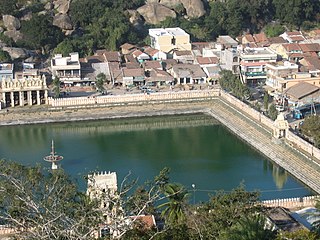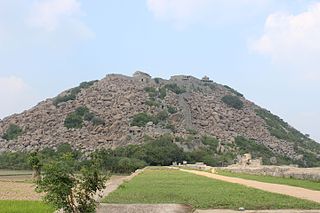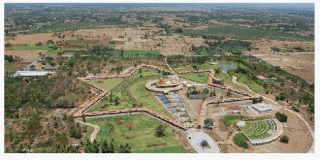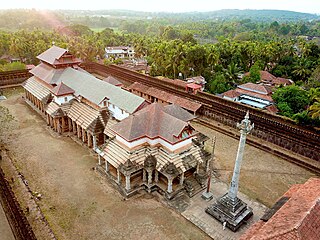
Tamil Jains are ethnic-Tamils from the Indian state of Tamil Nadu, who practice Jainism, chiefly the Digambara school. The Tamil Jain is a microcommunity of around 85,000, including both Tamil Jains and north Indian Jains settled in Tamil Nadu. They are predominantly scattered in northern Tamil Nadu, largely in the districts of Tiruvannamalai, Kanchipuram, Vellore, Villupuram, Ranipet and Kallakurichi. Early Tamil-Brahmi inscriptions in Tamil Nadu date to the third century BCE and describe the livelihoods of Tamil Jains. Samaṇar wrote much Tamil literature, including the important Sangam literature, such as the Nālaṭiyār, the Cilappatikaram, the Valayapathi and the Civaka Cintamani. Three of the five great epics of Tamil literature are attributed to Jains.

A matha, also written as math, muth, mutth, mutt, or mut, is a Sanskrit word that means 'institute or college', and it also refers to a monastery in Hinduism. An alternative term for such a monastery is adheenam. The earliest epigraphical evidence for mathas related to Hindu-temples comes from the 7th to 10th century CE.

A Bhaṭṭāraka heads traditional Digambara Jain institutions. He is responsible for training scholars, maintenance of libraries, managing endowments, presiding over installation ceremonies and running Jain institutions.

Humcha / Hombuja is a small town near Ripponpet, Hosanagara taluk in Shimoga district in the Indian state of Karnataka. Humbaja Atishaya Jain Teerth Kshetra is famous for being home to an ancient temple of Goddess Padmavati, and to the Humbaj Matha (seminary/monastery), an important institution of the Jain community. This temple is considered to be very holy and is known for its cultural and historical heritage. Other notable highlights of the place are a lake that reputedly never dries up and a tree that likewise always remains green.

Gingee, also known as Senji or Jinji and originally called Singapuri, is a panchayat town in Viluppuram district in the Indian state of Tamil Nadu. Gingee is located between three hills covering a perimeter of 3 km, and lies west of the Sankaraparani River.

Penukonda also called Penugonda is a town in the Sri Sathya Sai district of Andhra Pradesh, India. It is 70 km away from Anantapur town.

Shri Digambar Jain Lal Mandir is the oldest and best-known Jain temple in Delhi, India. It is directly across from the Red Fort in the historical Chandni Chowk area.

Jainism has been present in Maharashtra since ancient times. The famous Ellora Caves demonstrate that Jainism was part of a thriving religious culture in Maharashtra in premodern times.

Udupi Shri Krishna Temple is a well-known historic Hindu temple dedicated to Krishna and Dvaita Matha located in the city of Udupi in Karnataka, India. The Matha area resembles a living Aashram, a holy place for daily devotion and living. Surrounding the Shri Krishna Temple are several temples namely the Udupi Anantheshwara Temple which is over a thousand years old.

A Jain temple, Derasar or Basadi is the place of worship for Jains, the followers of Jainism. Jain architecture is essentially restricted to temples and monasteries, and Jain buildings generally reflect the prevailing style of the place and time they were built.

Sri Lakshmi Narayani Golden Temple complex inside the Thirupuram spiritual park is situated at the foot of a small range of green hills at Thirumalaikodi Vellore in Tamil Nadu, India. It is 120 km from Tirupati, 145 km from Chennai, 160 km from Pondicherry and 200 km from Bengaluru. The Maha Kumbhabhishekam or consecration of the temple and its chief deity, Sri Lakshmi Narayani or Maha Lakshmi, the goddess of wealth, was held on 24 August 2007, and devotees from all religions and backgrounds are welcome to visit.

Saavira Kambada Temple or Tribhuvana Tilaka Cūḍāmaṇi), is a basadi or Jain temple noted for its 1000 pillars in Moodabidri, Karnataka, India. The temple is also known as "Chandranatha Temple" since it honours the tirthankara Chandraprabha, whose eight-foot idol is worshipped in the shrine.

Tirumalai (lit. "the holy mountain"; also later Arhasugiri, lit. "the excellent mountain of the Arha[t]"; Tamil Engunavirai-Tirumalai, lit. "the holy mountain of the Arhar" is a Jain temple and cave complex dating from at least the 9th century CE that is located northwest of Polur in Tamil Nadu, southeast India. The complex includes 3 Jain caves, 2 Jain temples and a 16.25-foot-high sculpture of Tirthankara Neminatha thought to date from the 12th century CE that is the tallest Jain image in Tamil Nadu. Arahanthgiri Jain Math is also present near Tirumalai complex.

Jainism has an extensive history in the Indian state of Tamil Nadu, although practiced by a minority of Tamils in contemporary times. According to the 2011 India Census, Jains represent 0.12% of the total population of Tamil Nadu, and are of the Digambara sect. Tamil Jains are primarily concentrated in northern Tamil Nadu, in the districts of Madurai, Viluppuram, Kanchipuram, Vellore, Tiruvannamalai, Cuddalore and Thanjavur.

Jina Kanchi Jain Math, Melsithamur, is a Jain Matha that is located near Gingee, Villupuram district, Tamil Nadu, India.

Arahanthgiri Jain Math is a Jain Matha that established near Tirumalai in August, 1998. The Math is headed by Bhattaraka Dhavalakeerthi.

Vishwa Jain Sangathan (VJS) is a religious and social service organization of Jains in India. Amongst other things, it was involved in the Jain minority campaign.
There are references in Jain texts to various areas of Southeast Asia. During the reign of Samprati, Jain teachers were sent to various Southeast Asian countries.

The Hindu Religious and Charitable Endowments Department of the Government of Tamil Nadu manages and controls the temple administration within the state. The Tamil Nadu Hindu Religious and Charitable Endowments Act XXII of 1959 controls 36,425 temples, 56 mathas or religious orders, 1,721 specific endowments and 189 trusts.

The Humcha Jain temples or Humcha basadis are a group of temples found in Humcha village of Shimoga district in Karnataka, India. They were constructed in the 7th century CE in the period of the Santara dynasty and are regarded as one of the major Jain centres of Karnataka. The Padmavati Basadi is the most well-known of these temples.



















